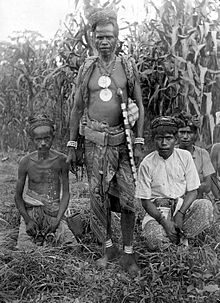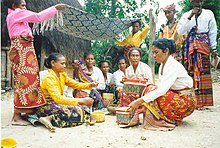Atoin Meto
The Atoin Meto ( atoni , "human"; meto , "dry", "indigenous"), Atoni Pah Meto ("people of the dry land") or Dawan , are the largest population group of West Timor that populates the entire central mountainous region which they call themselves pah meto ("the dry land"). The Atoin Meto also live in the exclave Oe-Cusse Ambeno , which belongs to East Timor .
population

As the dominant population of West Timor, the Atoin Meto are spread over ten territories with an informal political infrastructure that exists parallel to the Indonesian administration and is based on the structure of the social and political relationships of influential clan groups ( kanaf , like a name). The vast majority of this population lives in localized hamlets ( kuan ), which the Indonesian administration has meanwhile grouped together to form large villages ( desa ). The rhythm of the annual fluctuations of the wet and dry seasons determines and regulates the entirety of life in these settlements. The Atoin Meto operate subsistence farming and depend for their existence on their home and field gardens, in which they mainly grow maize and various types of vegetables. In every hamlet, cooperative, patrilineally related households ( ume ) form the focus of economic, social and ritual activities. If these activities are of a superordinate nature, the clan or the naming group ( kanaf ) are the community that carries out them. Each Atoin Meto is a member of one of these patrilinear and exogamous name groups, which refer to a defined territory ( pah ma nifu , land and sea; homeland) that consists of a multitude of named places. The history of these places extends into the immediate everyday life of the Atoin Meto; it reminds them of long past events that give the groups of names their existence and identity.
The total population for the Indonesian West Timor is given as 1.8 million (2010). In 2015, Oe-Cusse Ambeno, East Timor, had 68,913 inhabitants.
The language of the Atoin Meto is called Uab Meto (Dawan). In Oe-Cusse Ambeno they speak the Baikeno dialect .
history
It is believed that Australo-Melanesians lived around 40,000 to 20,000 BC. Reached Timor from the north and west during the last ice age. At that time, the Great Sunda Islands were connected to the Asian continent by land bridges, and the way across the sea to Timor was significantly shorter. Their descendants, the Atoin Meto, represent the original population of Timor and are characterized by very dark skin and straight, black hair.
If one assumes that the pirogue was not used until 7,000 BC. Was invented, one can assume that the stretches across the sea were made with rafts . 20,000 BC Agriculture was not yet common practice. The people lived together in small clans or tribes who moved around as hunters and gatherers without permanent settlements.
The Atoin Meto were later pushed back to the western part of the island by subsequent waves of immigration.
Artistic expressions
In the rituals of Atoin Meto, which accompany the life cycle of the individual, agriculture and house building, two different social groups, men and women, cooperate, whose artistic expressions contribute to the success of these rituals. The poetic use of language by men (word) and the textile motifs of women (picture) mutually create the required rites and thus fulfill their purpose. The prominent media in these rituals are oral poems ( tonis ) performed publicly by men as regional history and the demonstrative display of textiles produced by women as an indicator of territorial affiliation.
The social organization
The inseparable connection of a kinship group with a certain territory forms the basic principle of the social organization of the Atoin Meto. The basis and center of the social activities is the "minimal lineage", the lowest of the cooperating descent groups. Each lineage ( ume , house, household, family) as a local, unilinear descent group forms a relatively autonomous household ( ume ), the members of which are in an agnate relationship to one another: a man, his wife and their children, the adult sons and their families as well the man's brothers with his adult sons and their families. A Atoin metolachlor trees presents itself as an enlarged family in which two or more unrelated unilinear generations live. There is a strict, unavoidable rule of exogamy for such an environment; its members see themselves as a unit in relation to outsiders. The ume as "minimal lineage" is part of a clan ( kanaf , like a name; name group), which includes all those people who can trace their descent to a common - mythical and genealogically not directly verifiable - ancestor.
The traditional settlement pattern of the Atoin Meto is a hamlet called kuan ; one of these kuan represents the place of origin (as Omphalus), which marks the first land conquest by the ancestors. It is about the “holy rock, the holy spring”, the place that is intimately connected with the name of a group of names. A kuan does not represent a village in the usual sense: it is scattered farmsteads, each one inhabited by only one ume . The territorial complex kuan also forms the settlement area of a naming group ( kanaf ), one of the many unilinear units of descent whose members all have the same name. A name group is usually composed of four to ten ume . A "village" of the Atoin Meto consists of the members of a unilinear ancestry group; there are no other "villages" of the same ancestry; the members of the individual territorial associations are linked to one another by a strict rule of exogamy, that is, by relationships of mutual marriage and affinal kinship.
The political organization
In the past, West Timor was very insecure because of the sectional interests of individual lineages, villages and individuals; The power and influence of a small king ( raja , cf. Liurai ) usually did not extend beyond his territory. Autochthonous political conceptions of the Atoin Meto derive their legitimacy from the oral tradition. These are primarily verbal poems composed impromptu, which are recited in ritual speech by special functionaries (poet-speakers) in the rituals of the life cycle. The Atoin Meto organize geographical space, the territory that is identical to a certain political sphere of influence, using two principles:
a) According to a principle of reciprocity, which can be derived from family relationships, the Atoin Meto juxtapose different political groups - spatially oriented according to the cardinal points. The categories feto – mone (female – male) and olif – tataf (younger brother - older brother) serve as a structuring principle, which is supplemented and expanded by a third category - nanan – mone` (inside – outside). The mutual relations of these groups, their rights and duties, project the close interlocking between agnates and affinal relatives within the ume onto a territorial and political level. The political organization marks these relationships through the social position of individual political functionaries within social associations and in relation to territorial property.
b) In the political institutions of Atoin Meto the principle applies: At least two political units surround a center and are complementary to it (2 + 1, 4 + 1, 8 + 1). The spatial division of the territory into nanan-mone` (inside-outside) as well as the equation of these spaces with qualities such as passive-female or active-male is determined by the person of the Atupas (a sacred ruler with ritual functions for the political territory) and his represents four fetors (the secular rulers who exercise executive functions for the political territory).
religion

An intensive Protestant and Catholic missionary work of the Atoin Meto only began in this century (since 1910). Practicing Christians remain rooted in their indigenous religion. To what extent indigenous religious ideas, thinking and behavior, especially those of the rural population, still influence is difficult to judge under Indonesian nation-state discrimination. Corresponding to the social systems, the religious ideas of the Atoin Meto are also grouped around complementary polarities that underlie an anthropomorphic cosmos. Under the names uis neno (lord of heaven) and uis pah (lord of the earth) they personify and worship heaven and earth as the prerequisite and basis of their agricultural activities. Uis pah (the female earth) and uis neno (the male heaven) are understood as a complementary pair; together they form a divine duality in which the male uis neno exercises a certain hegemony. However, this hegemony does not go so far that uis pah is only understood as an emanation of uis neno . Both form different, independent, but not isolated units. They are not conceivable separately; one cannot exist without the other. The dry earth ( uis pah ) only becomes fertile through the life-giving rain, the seeds of heaven ( uis neno ). A sexual juxtaposition of heaven and earth ( Hieros Gamos ) is widespread thought in Timor and beyond in all of eastern Indonesia.
As the “god of water”, uis neno is identical to the crocodile (called uis oe , prince of water in the ritual speech ), whose abode is the coasts, rivers and lakes of Timor.
literature
- Clarke E. Cunningham: Atoni Borrowing Of Children: An Aspect Of Mediation . In: ME Spiro (Ed.): Proceedings of the annual spring meeting of the American Ethnological Society 1965, pp. 21-37.
- Clarke E. Cunningham: Categories Of Descent Groups In A Timorese Village . In: Oceania 37, 1966, ISSN 0029-8077 , pp. 13-21.
- Herbert W. Jardner : Textiles of the Atoni. Variations of a style in West Timor . (Master's thesis) Cologne 1988 ( Part 1 - Part 2 )
- Herbert W. Jardner: The Kuan Fatu Chronicle. Form and context of the Atoin Meto oral poetry (Amanuban, West Timor) . Reimer, Berlin et al. 1999, ISBN 3-496-02674-X ( publications of the seminar for Indonesian and South Sea languages of the University of Hamburg 23).
- Herbert W. Jardner, Heidrun Jardner: Captured threads. Textile decorating techniques in West Timor, Indonesia . 2nd revised and expanded edition. Abera-Verlag Meyer, Hamburg 1995, ISBN 3-931567-00-1 ( Austronesia 1).
- Andrew R. McWilliam: Harvest of the nakaf. A Study of Headhunting Among the Atoni of West Timor . B.Litt.thesis, Australian National University, 1982.
- Andrew R. McWilliam: Narrating the gate and the path. Place and precedence in South West Timor . Ph.D. thesis Australian National University, 1989.
- HG Schulte Nordholt: The Political System Of The Atoni Of Timor . Nijhoff, The Hague 1971, ISBN 90-247-5137-3 ( Verhandelingen van het Koninklijk Instituut voor Taal-, Land- en Volkenkunde 60).
- HG Schulte Nordholt: The Symbolic Classification Of The Atoni Of Timor . In: James J. Fox (Ed.): The Flow Of Life. Essays On Eastern Indonesia . Harvard University Press, Cambridge MA et al. 1980, ISBN 0-674-30675-9 ( Harvard Studies in Cultural Anthropology 2), pp. 231-247.
- Michael Rose: The Book of Dan. The Door in the Tree. Emergent Frameworks for Faith and Healing among the Meto of Timor-Leste , 2017.
Web links
- Atoin Meto Reloaded: Atoin Meto research project. atoinmetokultur.wordpress.com
Individual evidence
- ↑ ntt.bps.go.id/ ( Memento from July 21, 2011 in the Internet Archive )
- ↑ Direcção-Geral de Estatística : Results of the 2015 census , accessed on November 23, 2016.
- ↑ a b c A. Barbedo de Magalhães: Population Settlements in East Timor and Indonesia. University of Coimbra, Portugal, October 24, 1994



